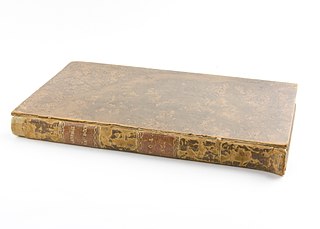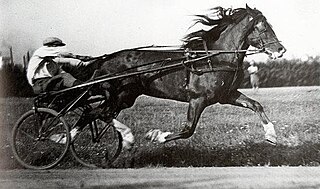
A horse breed is a selectively bred population of domesticated horses, often with pedigrees recorded in a breed registry. However, the term is sometimes used in a broader sense to define landrace animals of a common phenotype located within a limited geographic region, or even feral "breeds" that are naturally selected. Depending on definition, hundreds of "breeds" exist today, developed for many different uses. Horse breeds are loosely divided into three categories based on general temperament: spirited "hot bloods" with speed and endurance; "cold bloods," such as draft horses and some ponies, suitable for slow, heavy work; and "warmbloods," developed from crosses between hot bloods and cold bloods, often focusing on creating breeds for specific riding purposes, particularly in Europe.
Horse breeding is reproduction in horses, and particularly the human-directed process of selective breeding of animals, particularly purebred horses of a given breed. Planned matings can be used to produce specifically desired characteristics in domesticated horses. Furthermore, modern breeding management and technologies can increase the rate of conception, a healthy pregnancy, and successful foaling.

The mule is a domestic equine hybrid between a donkey and a horse. It is the offspring of a male donkey and a female horse. The horse and the donkey are different species, with different numbers of chromosomes; of the two possible first-generation hybrids between them, the mule is easier to obtain and more common than the hinny, which is the offspring of a male horse and a female donkey.

A hinny is a domestic equine hybrid, the offspring of a male horse and a female donkey. It is the reciprocal cross to the more common mule, which is the product of a male donkey and a female horse. The hinny is distinct from the mule both in physiology and temperament as a consequence of genomic imprinting and is also less common.
Impressive was an Appendix Quarter Horse, who earned his full AQHA registration in 1971. He was the 1974 World Champion Open Aged halter stallion, the first such World Champion in his breed, despite carrying only 48 halter points in total. He sired 2,251 foals, of which thirty went on to be World Champions themselves. The horse was inducted into the American Quarter Horse Hall of Fame in 2022.

A zebroid is the offspring of any cross between a zebra and any other equine to create a hybrid. In most cases, the sire is a zebra stallion. The offspring of a donkey sire and zebra dam, called a donkra, and the offspring of a horse sire and a zebra dam, called a hebra, do exist, but are rare and are usually sterile. Zebroids have been bred since the 19th century. Charles Darwin noted several zebra hybrids in his works.

The Hanoverian is a Warmblood horse breed originating in Germany, which is often seen in the Olympic Games and other competitive English riding styles, and has won gold medals in all three equestrian Olympic competitions. It is one of the oldest, most numerous, and most successful of the Warmblood breeds. Originally a cavalry horse, infusions of more Thoroughbred blood lightened it to make it more agile and useful for competition. The Hanoverian is known for a good temperament, athleticism, beauty, and grace.
A crossbreed is an organism with purebred parents of two different breeds, varieties, or populations. Crossbreeding, sometimes called "designer crossbreeding", is the process of breeding such an organism. While crossbreeding is used to maintain health and viability of organisms, irresponsible crossbreeding can also produce organisms of inferior quality or dilute a purebred gene pool to the point of extinction of a given breed of organism.

The Oldenburg or Oldenburger is a warmblood horse from the north-western corner of Lower Saxony, what was formerly the Grand Duchy of Oldenburg. The breed was built on a mare base of all-purpose farm and carriage horses, today called the Alt-Oldenburger. The modern Oldenburg is managed by the Association of Breeders of the Oldenburger Horse, which enacts strict selection of breeding stock to ensure that each generation is better than the last. Oldenburgers are tall sport horses with excellent gaits and jumping ability. The breeding of Oldenburg horses is characterized by very liberal pedigree requirements and the exclusive use of privately owned stallions rather than restriction to a state-owned stud farm.

The Holsteiner is a breed of horse originating in the Schleswig-Holstein region of northern Germany. It is thought to be the oldest of warmblood breeds, tracing back to the 13th century. Though the population is not large, Holsteiners are a dominant force of international show jumping, and are found at the top levels of dressage, combined driving, show hunters, and eventing.

A stud animal is a registered animal retained for breeding. The terms for the male of a given animal species usually imply that the animal is intact—that is, not castrated—and therefore capable of siring offspring. A specialized vocabulary exists for de-sexed animals and those animals used in grading up to a purebred status.
Voltaire was an influential sire of show jumpers and dressage horses. Additionally, he competed successfully at the international level in show jumping.

Go Man Go (1953–1983) was an American Quarter Horse stallion and race horse. He was named World Champion Quarter Running Horse three times in a row, one of only two horses to achieve that distinction. Go Man Go was considered to be of difficult temperament. While waiting in the starting gate for his first race, he threw his jockey, broke down the gate, and ran alone around the track; he was eventually caught and went on to win the race. During his five years of competition until he retired from racing in 1960 he had 27 wins, earning more than $86,000.

Thoroughbred breeding theories, or racehorse theories, are used by horse breeders in an attempt to arrange matings that produce progeny successful in horse racing. Bloodstock experts also rely on these theories when purchasing young horses or breeding stock. A basic understanding of these theories can also help the racing public understand a horse's theoretical genetic potential. The breeding theories stem from the belief that careful analysis of bloodlines can lend predictability to breeding outcomes. A well-designed mating increases the probability of the offspring's success, although many other factors also come into play.
Foundation stock or foundation bloodstock refers to animals that are the progenitors, or foundation, of a breed or of a given bloodline within such. Many modern breeds can be traced to specific, named foundation animals, but a group of animals may be referred to collectively as foundation bloodstock when one distinct population provides part of the underlying genetic base for a new distinct population.

This is a basic glossary of equestrian terms that includes both technical terminology and jargon developed over the centuries for horses and other equidae, as well as various horse-related concepts. Where noted, some terms are used only in American English (US), only in British English (UK), or are regional to a particular part of the world, such as Australia (AU).

The popular sire effect occurs when an animal with desirable attributes is bred repeatedly. In dog breeding, a male dog that wins respected competitions becomes highly sought after, as breeders believe the sire possesses the genes necessary to produce champions. However, the popular sire effect is not just down to wanting to produce a champion. For example, in Staffordshire Bull Terriers there are several popular sires who are used by breeders to produce specific colours that are not favoured in the show ring. The popular sire is often bred extensively with many females. This can cause undetected, undesirable genetic traits in the stud to spread rapidly within the gene pool. It can also reduce genetic diversity by the exclusion of other males.

Eri-Aaroni 3423 Valio was liver chestnut stallion who was a Ravikuningas title winner in harness racing and a very influential Finnhorse sire.
Average earnings index (AEI) is a popular statistic used in North American Thoroughbred horse breeding. It is used to put the earnings of a breeding animal's progeny into proper perspective.

Wolkentanz, also known as Wolkentanz I, was a champion Hanoverian stallion who stood at stud at the Celle State Stud in Germany. He was noted as a leading sire of dressage horses.













